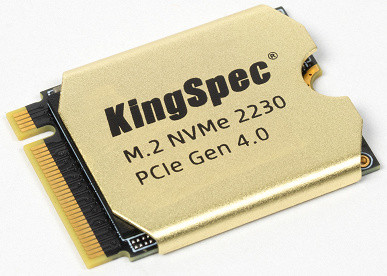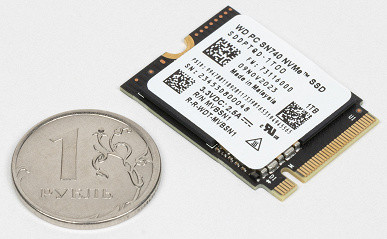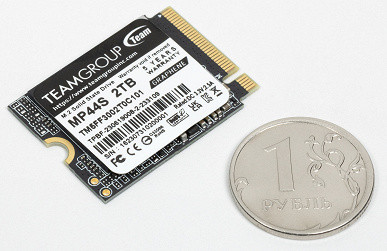We have already tested several M.2 2230 SSDs and discussed the reasons for their appearance and entry into the retail market. This is due to the fact that different devices require different component sizes. Standard M.2 2280, although the de facto standard for desktops, is ideal for laptops, where space is limited. Desktops are better suited to the U.2/U.3 formats common in servers, which can be installed in standard drive cages, which simplifies cooling and allows for the use of drives with higher capacities. Mostly, SSDs with several hundred gigabytes or 1-2 TB are purchased, which fits comfortably on a 2280 board. However, the need for larger drives is growing, which creates a demand for more compact formats.
For compact devices such as portable consoles, the 2280 formats are too large. Therefore, the 2260, 2242 and 2230 standards were developed for such cases. While these formats were initially used in OEM shipments, they were long overlooked by retail buyers. That changed with the introduction of the Steam Deck portable console, the base version of which only had 64 GB of eMMC, 20 GB of which was taken up by the operating system, leaving little room for games. The console included microSD card slots and an M.2 2230 slot, which in higher-end versions could accommodate 256 or 512 GB SSDs. These versions were significantly more expensive than the base, so many began looking for suitable drives to replace them themselves.
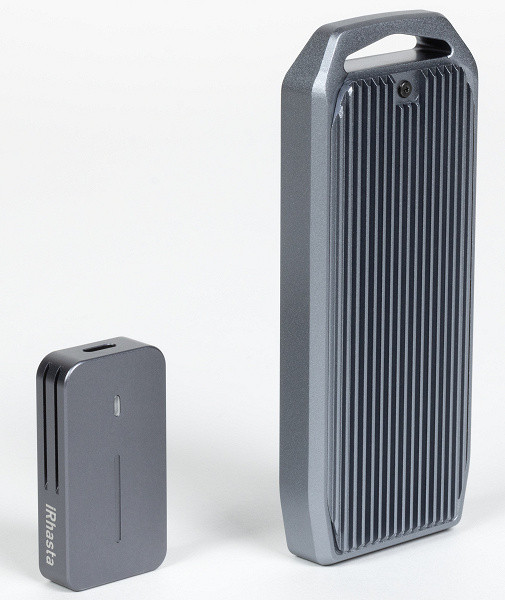
The situation with compact SSDs has become more complicated: starting with the second generation of Steam Deck, devices with empty slots are no longer sold. However, replacing the stock SSD may still make sense, as with the Asus Rog Ally console. Using an adapter, you can install M.2 2280, but due to the limited space in the case, this is inconvenient, so it is better to stick to the original design. As soon as manufacturers began selling compact SSDs at retail, sellers of compact USB boxes became more active, which are of interest to buyers due to their size. Currently, such devices only support USB3 Gen2 with a throughput of up to a gigabyte per second, while faster solutions, although they exist, remain expensive and less popular.
DIY projects for assembling CFexpress Type B memory cards (formerly XQD) are also popular. Such cards are expensive, but an adapter for an M.2 2230 SSD can be found for $5-6. This approach allows you to control the entire process and choose the right SSD with the required speed and temperature conditions. However, users should keep in mind that choosing the right SSD is important for efficient video recording and preventing overheating.
The demand for such compact SSDs has increased significantly. Previously, this demand was met through OEM models that were not formally intended for retail sale, but still made it to the market. However, many prefer to buy SSDs in stores with a warranty, instead of looking for suitable models on marketplaces from unverified sellers.
Offers from Chinese manufacturers who are actively engaged in the production of compact SSDs have also appeared on the market. They used bufferless four-channel controllers such as Maxio MAP1202 and MAP1602, which are well suited for the M.2 2230 format. Memory packaging remains an issue: although large brands have long been producing SSDs with 16 flash memory crystals in a single chip, Chinese manufacturers often use several chips for smaller volumes, which is cheaper, but not suitable for compact formats. In the future, with the development of technology, more capacious and faster solutions in the M.2 2230 format may appear.
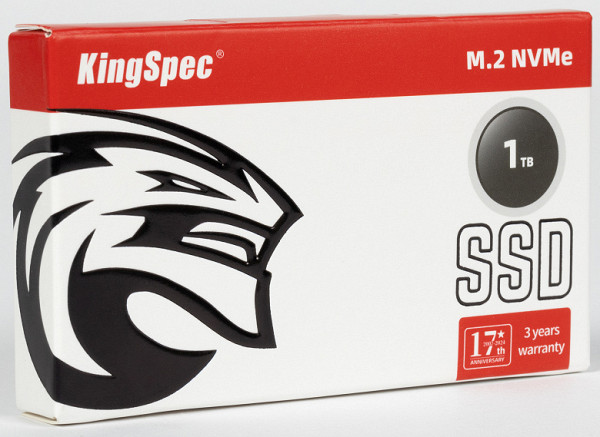
Not all manufacturers have managed to adapt to the new SSD format. One of the first was KingSpec, which began releasing its well-known NX series SSDs in 2230 and 2242 formats. However, the Maxio MAP1202 controller used in these models is already outdated and has been well studied in various configurations. The latest versions of KingSpec NX, which we got acquainted with, did not make a big impression.
Meanwhile, the new XF series of SSDs from KingSpec is a little more expensive, but offers PCIe Gen4 support and read speeds of up to 5 GB / s. These characteristics indicate the use of the Maxio MAP1602 controller, which is compatible with the MAP1202, but can reach higher speeds. Recently, «slow» versions of this platform have appeared, which, although less fast compared to the «fast» models offering up to 7 GB / s, still allow you to explore new variants of the 2230 SSD format and study previously untested versions of the platform.
KingSpec XF-1TB 2230 1TB
The manufacturer has equipped the drive with a small heatsink, which is probably intended both for cooling and to hide the components. However, this heatsink turned out to be too large for some installations; for example, it had to be removed to fit the SSD into a USB box. It would have been more convenient if the heatsink had not been glued, but was supplied separately in the package.
Software identification of the components was not a problem, and under the heatsink we found a Maxio MAP1602 controller and 128-layer YMTC TLC memory. This confirms that the same set of components is used inside as in previously tested models. Although no significant differences were found from previous tests, for most users this will not be an issue. It is worth noting that the memory in terabyte SSDs on this platform is slightly different — it uses paired 512 Gb crystals, which are usually found in 2 TB SSDs and are slower. It appears that other highly integrated options were not available, and using multiple memory chips for the 2230 format is difficult due to space limitations.
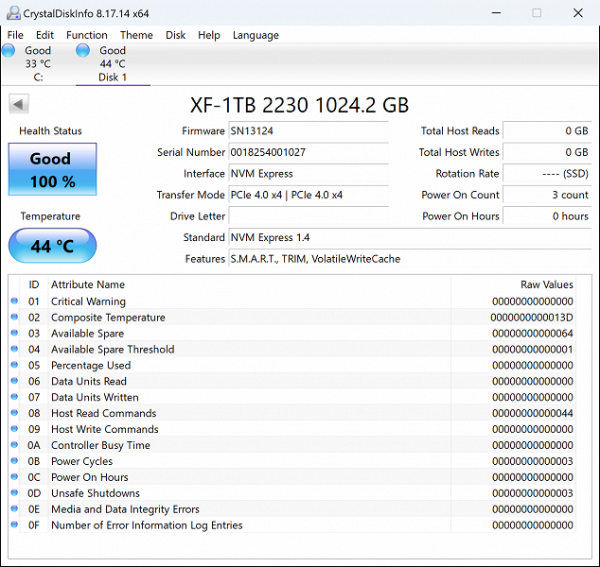
Overall, SSDs on this platform will show some differences from previously tested models. These differences can either be ignored or assessed using benchmarks and compared to other SSDs of the same form factor. At the moment, we have tested two SSDs — one fast and one slow. Today's model can take an intermediate position between them. All three SSDs support PCIe Gen4, which makes the comparison quite fair.
Testing
Testing methodology
We use a test rig with an Intel Core i9-11900K processor and an Asus ROG Maximus XIII Hero motherboard on the Intel Z590 chipset, which allows you to connect an SSD via two types of interfaces: PCIe Gen4, which comes directly from the processor, and PCIe Gen3, which is controlled by the chipset. Modern SSDs are designed for PCIe Gen4, which allows them to demonstrate maximum performance. However, testing on PCIe Gen3 is also important for compatibility, since the PCIe controllers in Intel chipsets have not changed since 2015. Today, we will focus on using the «native» mode to save space, since this will not affect unstudied platforms and all test participants will be tested in the conditions that they support.
Samples for comparison
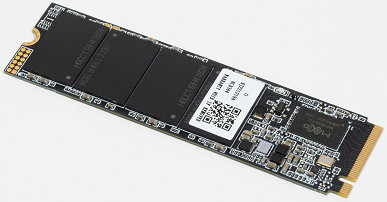
As mentioned, we have previously tested this platform in a full-size version. The main difference is that the TeamGroup MP44L uses 128-layer YMTC flash memory in a standard design, rather than paired dies. This circumstance allows us to evaluate the difference in performance and memory size, since paired dies can be slightly inferior compared to regular ones. In the case of KingSpec, the photo shows that their 1TB SSD consists of four chips, each containing four flash dies, as opposed to 16 dies packed into a single chip. The latter option is more expensive and is not always used unless necessary, but for the M.2 2230 format, this solution turned out to be more suitable.
When we first encountered the TeamGroup MP44S, we hoped that it would simply be a compact version of the MP44S. However, the reality turned out to be different: it uses a Phison E21T controller and 176-layer QLC flash from Micron. This solution has its advantages: QLC chips with a terabit capacity allow you to assemble 2 TB from 16 chips. This is a compromise between capacity and speed, which makes such an SSD a good choice for devices where capacity is critical, such as portable gaming consoles. However, for other cases where high speed is important, such a choice should be carefully considered.
The best example of a real compromise is the WD PC SN740 or Black SN770M. WD has TLC memory with terabit crystals, but this BiCS5 modification is the slowest in its class. In addition, such SSDs are the only ones with 2 TB with TLC until recently, which makes them significantly more expensive compared to their 1 TB competitors. Therefore, we will focus on the latter option in our testing. This will allow for the most direct comparison, since all four SSDs use 16 memory dies, providing optimal four-way interleaving on each of the four controller channels.
Filling in data
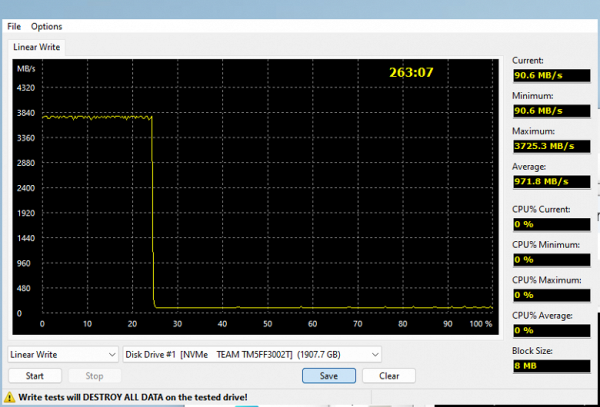
Life is pain. This expression perfectly describes the current situation with QLC memory. In the early years with TLC, everything looked similar — problems were aggravated by the low capacity of old SSDs. MLC was considered unsuitable for SSDs until the Intel X25-M showed how this memory could be used effectively. However, this is already history that many did not live or perceived in their youth.
Now QLC is a reality, and the problems with it are becoming relevant again. The main problem with QLC is the reduction in cost compared to previous memory types, but new problems remain. At the moment, the write speed of QLC remains at about 100 MB / s, which is far from ideal and raises concerns. Despite the improvements, such numbers can still be scary, and for good reason.
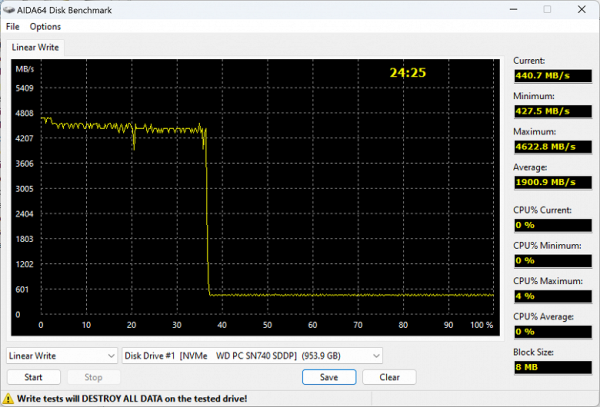
When we talk about caching issues, this is what we mean. For example, in the WD Black line, which is presented in the consumer segment as a top option, the controller, although unbuffered and four-channel, remains one of the most powerful in its class. The memory is fast, but the write speed after exhausting the SLC cache is only 440 MB/s. This is significantly better than 90 MB/s in other examples, but still three times less than when writing to garbage in the second pass. The reason is that in addition to writing new data, it is necessary to simultaneously compact old data previously written to the cache. However, most users usually focus on the maximum write speed and expect that a large cache will minimize problems, which in reality is often justified.
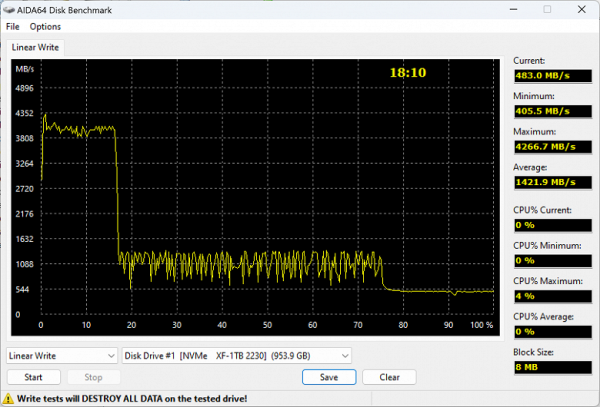
Maxiotek firmware often uses a different approach: a small cache with fast writing directly to the main memory array. As the cache fills up, the write speed drops to a level similar to WD, but the advantage is that almost 2/3 of the volume is written at a speed of about 1 GB / s. The fact that the maximum speed is achieved with 1/6 of the free space may not be so noticeable. In general, the time to write a full terabyte is reduced. Each approach has its pros and cons. For external SSDs, we would prefer this scheme, since M.2 2230 drives are often used in such cases.
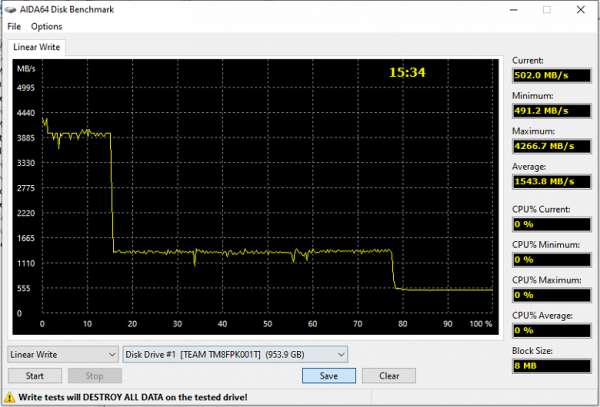
Team on the same platform shows better results: the recording is completed three minutes faster, and the direct recording graph is smoother. This is due to the use of paired crystals, which can reduce performance, but in this case the effect is not too noticeable. The peak write speed is also very accurate, almost to the milliliter.
Maximum speed characteristics
Low-level benchmarks like CrystalDiskMark 8.0.1 have long since fallen victim to the SLC caching craze and effectively only test cache. Manufacturers also limit performance data to within the cache, so checking their results is always useful. The main goal of caching is to ensure high real-world speeds despite the falling cost of memory.
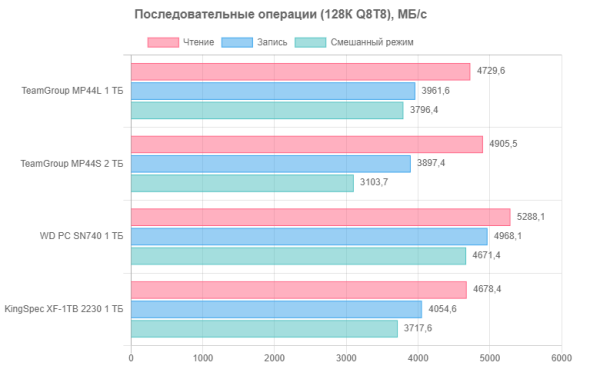
The benchmark results mostly reflect the effectiveness of caching, which is designed to hide the weaknesses of main memory. So it’s no surprise that they look the way they do. WD does well even among the most modern platforms, considering that this is essentially the second iteration. While the MAP1602 is more powerful than the Phison E21T, the difference is not as noticeable in sequential scenarios and within the cache.
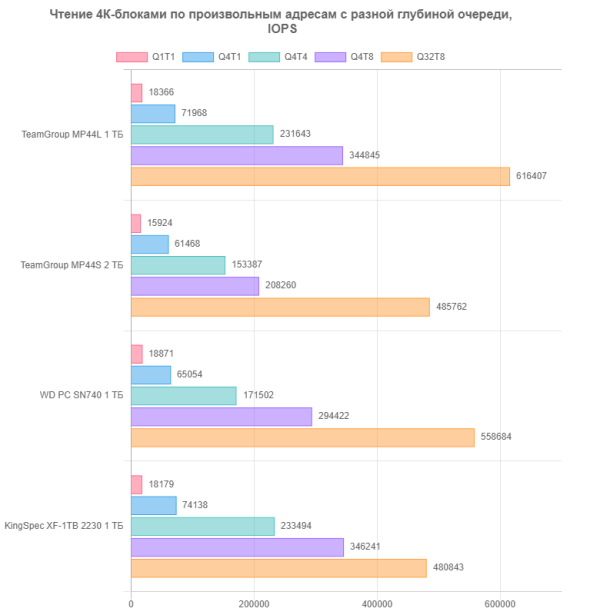
But the differences become noticeable at random addressing. Although this test is rarely used in practice, it is useful for comparing different platforms or versions of the same platform. For example, two SSDs based on MAP1602 and 128L YMTC show different results in the longest queues, which is due to small differences in memory. Such details can be important for deep analysis.

Sometimes a more compact SSD can be faster than its larger «relative», which can be explained by differences in firmware. Although tests are often synthetic, firmware plays a significant role in performance. For example, Phison programmers continue to improve their solutions, and this is noticeable. Other manufacturers are also not far behind, offering their own optimization options.
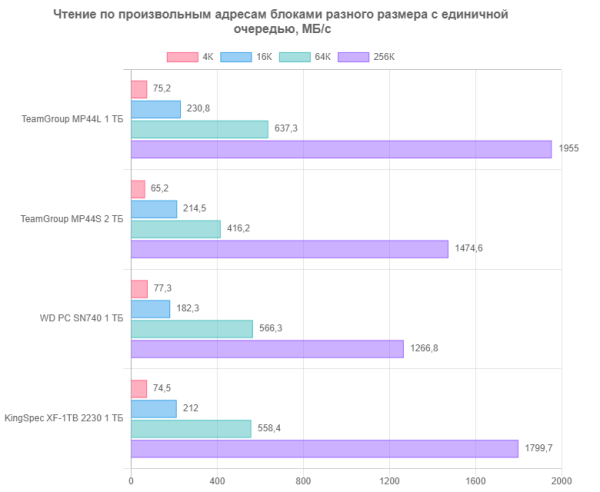
It would be better if this enthusiasm for optimization were directed to more practical tasks. For example, increasing the block size and improving the processing of long queues, which is really important in practice. Currently, many devices cope with loads that do not cause problems in real conditions. However, for modern application software and current requirements, the achieved level is quite sufficient — a reserve for several years to come.

Again, Phison and Maxiotek programmers deserve credit for their optimization efforts. While these efforts are not always critically necessary, given that today's low-cost SSDs already exceed the software requirements, they do help improve performance and stability.
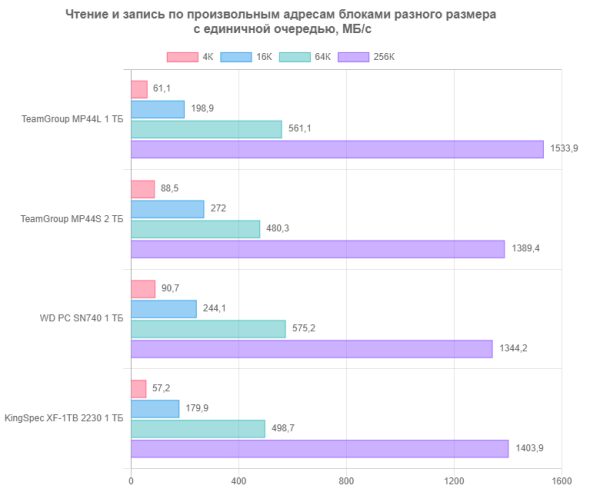
Mixed mode is also important because in real-world use (as opposed to testing), there is rarely a situation where data needs to be written only or read only. This is especially true in multi-tasking environments and given the complex operations of modern operating systems. In this scenario, we probably won't see anything new — it's just a repeat of what has already been tested in other conditions.
Working with large files
While the low-level utilities may show impressive results, in practice, such speeds are not always achievable. This is because tests like CrystalDiskMark use small amounts of data, which often remain in the SLC cache for the duration of the test. Real-world data writes involve not only writing to a file, but also modifying file system metadata such as the MFT and journals, which requires writing to different locations and sometimes in small blocks. So for a more accurate assessment of practical performance, it is better to use tools like the Intel NAS Performance Toolkit, which allow you to test not only the cache, but also the device in more realistic conditions, when free space is almost limited, which is what we do.
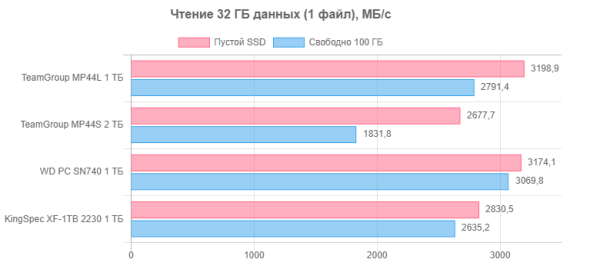
Single-threaded scenarios are the most common, but also the most difficult to test. Modern SSDs already demonstrate excessive speeds even in such conditions. Even if reading is performed not from the SLC cache, but from the main memory array, the performance remains high. Our SSD tested today is slightly inferior to a larger similar device, but in real conditions this difference is no longer so significant.
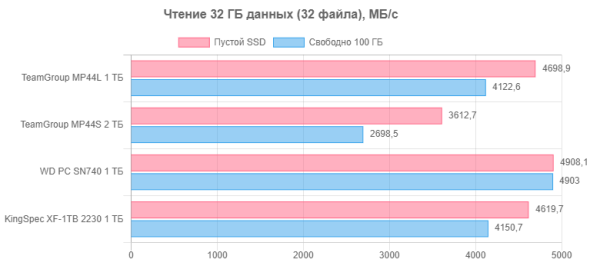
Unfortunately, the multi-threaded mode is still more synthetic than practical — otherwise life could speed up significantly :) But the trends here are absolutely the same as in the previous case.

The write speed depends on the efficiency of the SSD cache and the algorithms embedded in the firmware. In the three tested drives, when the cache is full, its size is slightly insufficient for the entire file. However, this only significantly affects the TeamGroup MP44S, where the write speed outside the cache drops too sharply. At the same time, the KingSpec XF-1TB 2230 demonstrates stable results due to good firmware optimization.
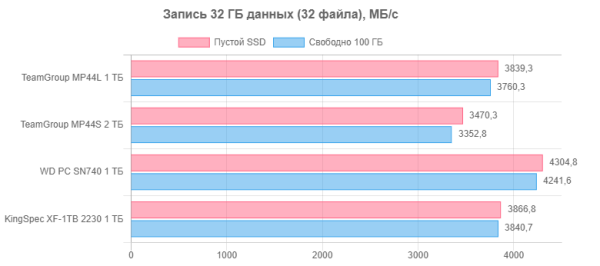
These two scenarios are very different for traditional hard drives, but inside the SSD everything comes down to a common denominator. The possibilities for optimization are limited here, so the two devices based on the MAP1602 show similar results and are noticeably inferior to the WD PC SN740, where the entire test scenario fits into the cache. In the current conditions, what is more important is not further speed increase, but the efficiency of the software (including the system) in using the already available capabilities.
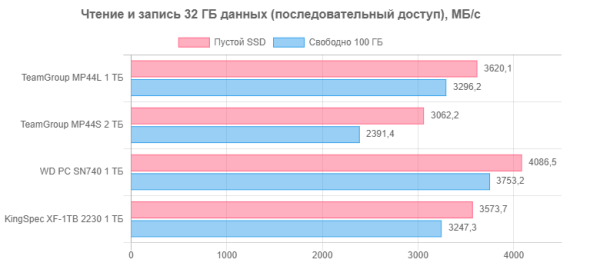
As before, we see that «cross-cutting» scenarios are still somewhat more challenging for budget platforms compared to pure writes or reads. However, speeds are already measured in gigabytes per second, especially if SLC caching is used effectively. When there is not enough cache, speeds drop, which encourages manufacturers to increase its volume. SSDs on QLC memory, with the exception of Intel/Solidigm products, usually show noticeable problems. Therefore, it is better to avoid QLC memory if possible, since TLC, even in budget controllers, provides more stability of performance.
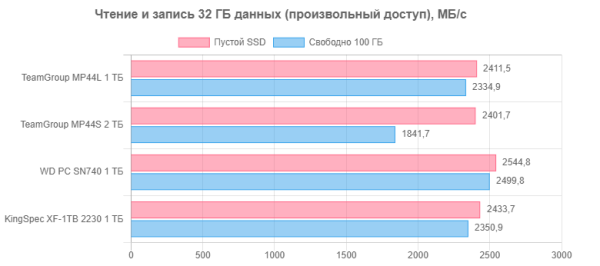
Random addressing is still more complex than sequential, but it already shows amazing results compared to the last decade. Unfortunately, the software has been optimized for hard drives for a long time, which are several orders of magnitude slower in such conditions. Therefore, it remains to record the achievements of developers and note that over time, platforms are improved thanks to firmware updates, which is often reflected in tests.
Comprehensive performance
Currently, the best comprehensive benchmark for evaluating storage devices is PCMark 10 Storage, which you can read more about in our review. We noted that of the three tests included in the suite, the most useful is the «Full System Drive» test, which covers almost all common scenarios: from loading the operating system to regular data copying. The other two tests are just subsets of this one, and, in our opinion, less informative. «Full System Drive» is useful for accurately measuring not only the real throughput in practical tasks, but also the delays that occur. Although averaging these metrics across scenarios leads to slightly synthetic results, this is currently one of the closest estimates of storage performance to reality.
The total write volume in the tests is 200 GB, which is guaranteed to exceed the cache size, especially if there is only 100 GB of free space. Pauses for clearing the cache are practically absent in reality, which makes testing PCMark 10 Storage more difficult and pessimistic compared to real conditions. In real life, the time to perform the same operations often extends over a day or a week, which reduces the number of problems at the expense of time spent cleaning up garbage. However, for future planning and performance evaluation, it can be useful to focus on this pessimistic scenario to avoid underestimating potential problems.
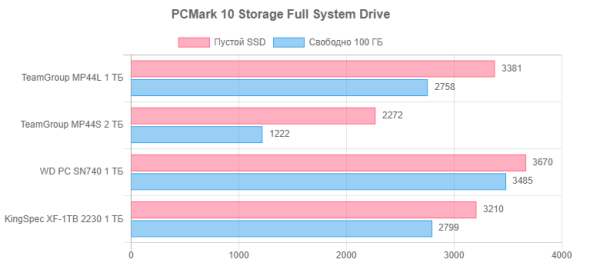
Currently, the best comprehensive benchmark for evaluating storage devices is PCMark 10 Storage, which you can read more about in our review. We noted that of the three tests included in the suite, the most useful is the «Full System Drive» test, which covers almost all common scenarios: from loading the operating system to regular data copying. The other two tests are just subsets of this one, and, in our opinion, less informative. «Full System Drive» is useful for accurately measuring not only the real throughput in practical tasks, but also the delays that occur. Although averaging these metrics across scenarios leads to slightly synthetic results, this is currently one of the closest estimates of storage performance to reality.
The total write volume in the tests is 200 GB, which is guaranteed to exceed the cache size, especially if there is only 100 GB of free space. Pauses for clearing the cache are practically absent in reality, which makes testing PCMark 10 Storage more difficult and pessimistic compared to real conditions. In real life, the time to perform the same operations often extends over a day or a week, which reduces the number of problems at the expense of time spent cleaning up garbage. However, for future planning and performance evaluation, it can be useful to focus on this pessimistic scenario to avoid underestimating potential problems.
Total
Let's look at the situation as a whole. The main thing is the expansion of the range of compact SSDs, not specific models. A year ago, the market was completely different: there was demand, but it had to be satisfied mainly through OEM models. Now, with the growth of demand, there are many retail offers from different companies. WD adapted its OEM SSDs for retail, Phison offered reference solutions for the 2230 format, and Chinese manufacturers expanded their offerings.
As for the technical aspects, there is nothing unexpected in the KingSpec NX and XF series SSDs. Maxio MAP1202 and MAP1602 controllers are well suited for the M.2 2230 format, and previously the only thing that held companies back was the higher cost of dense flash memory packaging. However, no one wants to miss out on a potential market. We would be interested to see the MAP1602 with 232-layer YMTC memory, not so much because of the increase in speed, but because of the possibility of releasing full-speed 2 TB drives in this format. There is a demand for such disks, albeit small, and over time, supply will also appear.
As for existing models, the form factor does not affect performance. Prices play a big role: with equal characteristics, many prefer proven brands, but the opportunity to save money also attracts buyers. An increase in the number of offers at the average price level always has a positive effect on the market and will definitely not disappoint buyers.

